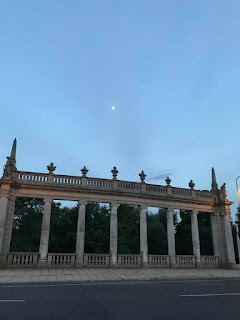Aber die Brücke gibt es hier schon lange, seit 1660 ungefähr, damals aus Holz und eher eine Abkürzung, um zu den Jagdgründen um das Gut Klein Glienicke herum zu gelangen. 1777 wurde die Brücke neu gebaut, größer und mit Geländer, sowie Kontrollhäuschen für den Brückenmaut, den alle bezahlen mussten, also alle, außer den Adligen.
Als die Fahrzeuge zahlreicher und der Verkehr immer dichter wurde, musste die Holzbrücke weichen. Schinkel baute 1831 neu und aus Stein, aber auch dieses Bauwerk war nicht lange dem Verkehrsaufkommen gewachsen. Die heutige Brücke stammt aus dem Jahr 1907 und natürlich fanden sich auch damals Leute, die nörgeln mussten, plumpe Eisenkonstruktion und so weiter. Was aus den Nörglern wurde ist ungewiss, die Brücke selbst ist heute Weltkulturerbe, bätsch!
Auf der Potsdamer Seite stehen vor der Brücke noch neogotische steinerne Kolonnaden, die auf das Potsdamer Stadtschloss hinweisen sollten und kürzlich restauriert wurden, da die Stahlstifte in den Sandsteinbauwerken korrodiert waren.
Die Brücke ist zweifarbig grün, heller auf der Potsdamer und dunkler auf der Berliner Seite und in der Mitte zeigt eine Platte im Boden, wo einst die Welt getrennt war und auf beiden Seiten informieren Tafeln ausgiebig über die Geschichte des Bauwerks.
Mittlerweile ist es 21.45 Uhr und der Sonne ist eingefallen, dass sie ja morgen früh aufstehen muss, also verschwindet sie irgendwo in der Havel und lässt ein phantastisches Abendrot zurück. Nun wird es gleich dunkel und ich nehm den letzten Bus, der aus Berlin kommend nun ungehindert nach Potsdam fahren kann und außer einem Fahrschein wird nichts kontrolliert. Ich mag eine Welt ohne Grenzen...
It’s 9pm and the sun doesn’t want to go to sleep, so I don’t too. Not far from my new favourite hotel the city of Potsdam already endet, because the Berliner Vorstadt (Berlin’s Suburbs) is exactly that, the door yard of Berlin. Both cities are separated by river Havel and connected by an impressive truss bridge made of steel. Mostly know is the bridge as the Bridge of Spies, during the Cold War political prisoners have been exchanged between both sides three times and Steven Spielberg made a movie about it and took us back in the year 1962 when he changed the location into a movie set (https://de.m.wikipedia.org/wiki/Bridge_of_Spies_–_Der_Unterhändler).
But the bridge is here much longer, since 1660, when a wooden bridge was built as a short cut to the hunting ground near the manor Klein Glienicke. 1777 the bridge was renewed, was bigger and with a handrail then and a tall collector’s house, to collect the tall anyone had to pay, anyone but the nobles.
The vehicles became more and the traffic dense and the wooden bridge had to be replaced by a new and bigger one. Schinkel did it, 1831 a new stone bridge was built and even this one couldn’t bare the increasing traffic volume. Today’s bridge is from 1907 and of course also back in time have been folks complaining about and calling it a clumsy iron construction, no idea what those nagger are doing today, but the bridge is world cultural heritage today, tee-hee.
At the Potsdam side in front of the bridge arises neogothic stone colonnades which should give a hint of the Potsdam city castle. They have been renovated shortly, because the steel pins inside the sandstone pillars have been corroded.
The bridge colour is two tone, light green at the Potsdam side, a darker green at the Berlin one and in the middle a plate in the ground shows where the border between two worlds has been. At both sides bill boards inform abundant about the history of the building.
Meanwhile it’s 9.45pm and the sun remembers that she has to go up early tomorrow, so she’s going down somewhere in river Havel and leaves a perfect evening glow. Soon it will be dark and I take the last bus, that, coming from Berlin and goes straight to Potsdam with no control, except the bus ticket. I love a world with no borders...

































































